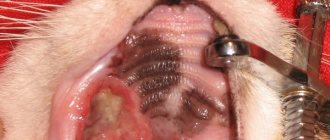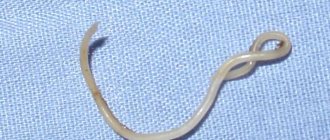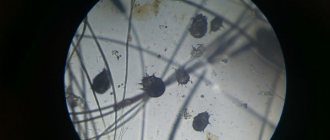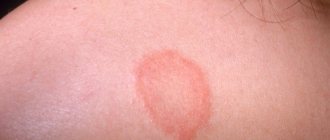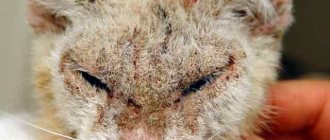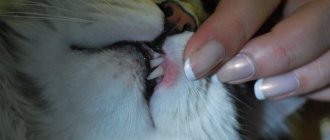Sarcoptic mange in cats is a type of mange that is caused by parasites of the genus Sarcoptes. Microscopically sized mites devour the epidermis, causing discomfort and pain to the animal. Diseases of domestic animals are a cause of concern for caring owners.
Sarcoptic mange appears due to the presence of Sarcoptes canis (itching mite) in the animal. It can be transmitted from one pet to another. It is worth noting that it is not possible to identify the causative agent of this disease on the body of an animal. The fact is that ticks are incredibly tiny (body length ranges from 0.2 to 0.4 mm). The presence of this mite on the surface of a cat’s skin can only be determined under a microscope.
Sarcoptic mange in dogs and cats: symptoms, diagnosis, treatment
Animal sarcoptic mange, or scabies, is a parasitic disease characterized by skin lesions, the formation of crusts and scabs, baldness, exhaustion of the animal and severe itching.
The causative agents are ticks that infect domestic and wild animals, as well as humans, and parasitize on or inside the skin. They feed on lymph, tissue fluid, serous exudate and dead epithelium. The life cycle of ticks takes place on the body of the host. It can be divided into 4 phases: egg, larva, two nymphs and adult. Sarcoptoid mites are species specific. This means that each animal species has its own specific type of tick.
Sarcoptic mange in cats and dogs, caused by these mites, is usually called scabies based on its main clinical sign. The causative agent is the itch mite Sarcoptes canis, belonging to the phylum Arthropoda, class Arachnida, family Sarcoptidae, genus Sarcoptes. These are small, round mites with short legs and gnawing mouthparts. Sarcoptos are intradermal parasites that most often settle on the dorsum of the nose, brow ridges, and at the base of the ears; they can parasitize the chest, lower abdominal wall and other parts of the body.
Females make passages in the stratum corneum of the skin, then lay 2 to 6 eggs. After 2-3 days the larvae appear, after another 3-4 days they molt and turn into protonymphs, then into teleonymphs. Ticks become adults in 4-7 days. The general development cycle takes from 15 to 19 days, life expectancy is 45-55 days.
Sarcoptic mange is widespread in dogs and cats. Infection occurs both through physical contact between animals and through care items. When it comes into contact with the skin of a nonspecific host (human), the parasite causes “pseudoscabies.” Symptoms of such scabies are redness of the skin and slight itching. However, the disease passes quickly, since there are no favorable conditions for the development and reproduction of ticks.
Signs of the disease appear 10-20 days after infection. Papules and vesicles appear on the skin of the bridge of the nose, eyebrows and ears. Animals itch a lot, scratches, scabs, and crusts appear. The skin becomes dry and hair falls out. Dandruff and severe itching may occur with an atypical course. Often the disease exhibits a generalized character. If the above symptoms occur, you must contact a specialist for an accurate and quick diagnosis.
The diagnosis is made based on a clinical examination of the animal and laboratory tests. A deep scraping is made (until blood appears) along the border of healthy skin and the affected area. The smear is moistened with a 10% solution of alkali or kerosene. Then examined under a microscope.
Sick pets are isolated from healthy people and animals. Treatment for sarcoptic mange in cats and dogs begins with bathing in warm water and keratolytic shampoos. The hair in the affected areas is cut off. Acaricidal preparations are used: ointments, emulsions, aerosols. Dogs and cats that have been in contact with patients are also treated and treated. New animals are quarantined for 30 days, and if pustules, crusts, or vesicles appear, scrapings are made and examined.
The premises where animals and care items are kept should be thoroughly cleaned and disinfected.
For prevention, it is necessary to follow the rules of personal hygiene, since mites can penetrate human skin and cause allergic reactions.
Vishnevskaya Maria, paramedic of the mobile service Moscow city veterinary assistance Call a doctor to your home, (495) 747-77-05.
Main symptoms of the disease
At the first stages, sarcoptic mange in cats has no symptoms. The beginning of the tick's breeding season does not appear in the skin. The first signs of skin lesions usually appear 10-12 days after infection.
Mites reproduce quickly enough, so in just a day the following can be found on the skin under the fur:
- small rash turning into dense bumps and/or blisters;
- scratching turning into extensive ulcers;
- increased peeling of the skin, dandruff, crusts from the dried contents of the blisters, distributed throughout the body;
- obvious severe itching.
The main places of localization of skin manifestations:
- collar area (neck and withers);
- areas of skin along the spine;
- area around the tail;
- occasionally - the inner surface of the thighs;
- in the generalized form, the head may be affected - the brow ridges, cheeks, beard, ears, crown.
In addition to local manifestations, sarcoptic mange in cats is accompanied by general symptoms of malaise:
- lethargy, apathy, drowsiness;
- sudden sharp movements, jumping, meowing (a sign of unbearable itching);
- tousled hair falling out in clumps in areas where scratching and rashes occur;
- increased hair loss over the entire surface of the body;
- noticeable weight loss;
- In affected areas, the skin may change color (darken) and thicken.
https://youtu.be/https://www.youtube.com/watch?v=egMGtyiEAeE
Types of mite scabies in cats
Since there are several types of scabies pathogens, it is necessary to accurately diagnose and treat accordingly. The need to identify a specific type of tick is also required in order to determine how dangerous the disease is for humans and whether it will require further prevention and treatment.
- Sarcoptic mange.
The rarest form of the disease, it usually affects people and dogs. Also called scabies itch. The peculiarity of this form of scabies is that it manifests itself in rapid baldness of places with the shortest hair: in the area of the ears, abdomen and muzzle; Sarcoptic mange in the muzzle area - Scabies mite of the Notoedres cati type.
The parasite multiplies quickly and is microscopic in size. The pathogen provokes an intractable itch that causes the cat to scratch the skin until it bleeds. This causes a secondary infection and suppuration of the wound. The constant release of blood attracts other parasites, which further worsens the animal’s condition. The disease spreads from the muzzle and ear, after which it spreads to the body; Notoedres cati under a microscope - Demodecosis.
An absolutely non-infectious form for humans, provoked by the pathogen Demodex cati. The mite lives permanently in hair follicles and sebaceous glands and dies on human skin. It is considered conditionally safe for cats, as it manifests itself only with a severe decrease in immunity. The disease can appear on any part of the body, most often also in the eye area; Demodectic mange is especially dangerous for kittens. - Otodecosis.
This type of scabies is caused by a mite that lives in the ear and immediately dies on human skin. The main signs of the disorder include severe itching, the appearance of crusts in the ear canals, and discharge of pulp from the ear. If detected early, it can be cured quickly. Otodectosis is easily treated, but often relapses upon contact with an infected animal
Symptoms
Sarcoptic mange of ducklings and cats has the main symptom - constant, painful itching. An infected animal scratches its skin to the point of wounds, becomes nervous and restless, rolls on its back, and twitches. Additional clinical signs include:
- crusty blisters in the nose and ears. The first papules form 10 days after infection. They burst, leaving behind ulcers that itch and hurt unbearably. The animal scratches them, infecting healthy areas of the body;
- severe peeling of the skin;
- the presence of areas of baldness.
The intensity of the itching does not depend on the number of mites. Even in small populations, parasites can cause an acute allergic reaction in a cat. If at the beginning sarcoptic mange affects the head, then later the disease spreads to the neck, chest, and torso. In advanced cases and with extensive damage:
- the cat loses its appetite, becomes lethargic, its body is exhausted;
- the crusts covering the papules become rough and keratinized and acquire a gray color;
- purulent infection is observed, accompanied by severe pyoderma;
- Deep scratching is accompanied by secondary infections;
- the natural functions of the skin are lost, which leads to irreversible consequences and damage to the nervous system;
- cachexia develops, ending in the death of the animal.
Diagnosis of the disease
Before prescribing treatment, it is necessary to conduct a diagnosis. Skin diseases have many similarities with each other
Therefore, it is important to make a correct diagnosis. The professionalism of the attending physician can be a key element in this case.
If the diagnosis is erroneous, the disease will not only not be cured, it will progress and may provoke disruption of other functions of the body. A number of examinations are used for diagnosis, which helps to identify the true cause.
- Let's look at the main diagnostic measures:
- initial examination by a veterinarian - the doctor visually examines the patient and assesses his condition and the condition of the skin. It is necessary to tell how your pet’s condition has changed over the last 72 hours, this will help the veterinarian create a more detailed picture when diagnosing the disease;
- blood tests - after taking a blood test, the doctor looks at changes in indicators, some numbers may indicate changes in the functioning of internal organs, as well as indicate an inflammatory process in the body;
- Microscopic examination of skin scrapings is probably the most basic procedure that helps to identify sarcoptic mange from other diseases. Using a scalpel, material is taken from the affected area and examined using a microscope.
If there are suspicions of concurrent diseases, additional studies may be prescribed.
Development of the disease in cats
Sarcoptic mange in cats is caused by the Arthropoda mite, which belongs to the genus Sarcoptes. The tick cannot fully develop into a non-host and soon dies. The full life cycle of the parasite is 40-55 days. The females make their way into the stratum corneum of the skin, where they lay eggs, from which the larva hatches after 3 days, after 4 days it molts and becomes a nymph, before becoming a full-fledged tick, the nymph molts several more times.
Signs of illness
Symptoms of sarcoptic mange appear in cats, as in dogs, affecting the skin. In the area of the head, on the ears, nose, and near the eyebrows, vesicles and pustules filled with liquid appear, which cause constant itching, leading to the formation of scabs, scratching the skin until it bleeds. In these places, hair falls out, and the skin becomes rough and begins to crack. The photo on the Internet shows what the affected area of the skin of a sick animal looks like.
Important! Try to ensure that your pets do not “communicate” with “vagrants” when walking, and do not eat in garbage dumps. Then you will have peace of mind for their health, and in some cases for your own.
Diagnosis is based on a clinical examination of the pet by a veterinarian and through laboratory tests, for which it is necessary to take a skin scraping in the affected area and study it under a microscope.
A sick pet must be isolated from other animals and its contact with other family members must be minimized. One of the most effective, although expensive, methods of treatment are drops on the withers Advocate of the German company Bayer. A one-time application protects the animal from sarcoptic mange for up to 28 days, which is enough for a complete recovery. The use of sulfur and aversectin ointments gives positive results in the fight against the disease. They should be used several times a day for 5 days. The complex remedy Amit, containing anti-inflammatory and antibacterial substances, copes well with infection.
In more severe cases, it is possible to use drugs that are administered subcutaneously; they act quickly and effectively due to the fact that they act from the inside. One of these is aversect, applied at the rate of 0.2 ml per 10 kg of weight twice with an interval of 5 days. Bathing with keratolytic shampoos also gives a good result in the fight against scabies. It is necessary to put a funnel on the treated animal to avoid licking and poisoning of the pet. In parallel with treatment, the room where the infected animal is kept should be disinfected.
Leakage in pigs
Sarcoptic mange in pigs is caused by the Sarkoptessuis mite, which infects the epidermal layers of the skin, most often in the areas where the hairs emerge, where the skin is thinnest. Animals constantly scratch, tearing the skin until it bleeds, thereby provoking the formation of scabs. The photo in the medical literature shows what infested pigs look like.
The disease most often affects young individuals under one year old, with not yet strengthened immunity. If the disease is not treated, then upon reaching six months of age the disease enters the chronic stage. In adults, infestation is noticeable upon closer inspection.
Despite the pronounced signs of sarcoptic mange, in order to obtain the correct conclusion, the skin of affected pigs is scraped until blood appears for diagnosis.
Therapy
Treatment for sarcoptic mange in pigs should begin with softening and removing hardened parts of the body. After which the young animals are bathed, and the adults are sprayed with such agents as 2% SK-9 emulsion, 2% chlorophos solution, TAP-85 preparation, 1% creolin soap solution, 1.5% trichlorometaphos. When treating animals with liquid solutions, the inner surface of the ears should be carefully treated.
Note! The information about treatment on this site is provided for informational purposes only; only a veterinarian can determine the correct diagnosis and prescribe medications.
Consumption of meat from processed animals is permitted no earlier than 10 days after the last spraying with chlorophos, trichlorometaphos-3 after 45 days, and only two months after the use of creolin and TAP-85.
For preventive purposes, sanitary requirements should be observed, livestock should be periodically inspected, and contact of sick animals with healthy ones should be prevented. New animals entering the farm should be quarantined for 30 days and treated with acaricidal agents for preventative purposes.
source
Collapse
The causative agent of sarcoptic mange
Diagnostics
The doctor must distinguish the symptoms of a tick infestation from atopic dermatitis or food allergies. The only way to prove a diagnosis of sarcoptic mange or notoedrosis is by detecting the mite in skin scrapings.
If mites are not found, this does not exclude pruritic scabies, so often the doctor prescribes acaricidal drugs based on clinical signs.
Compliance with scraping rules increases the chances of success:
- Ticks are looked for in places covered with crusty papules (the tick or its eggs may be under such a crust).
- There is no need to waste time finding a place to scrape.
- Using a dull scalpel blade, the doctor scrapes the skin until blood appears.
- The scalpel and glass slide are lubricated with petroleum jelly or liquid paraffin, this makes it easier to capture the scraped material on the blade and transfer it to the glass for microscopy.
- The sample is looked for not only for adults, but also for eggs or fecal clots of parasites.
Diagnostic methods include trial treatment. The doctor prescribes treatment for pruritic scabies, strictly adhering to the protocol, as if the diagnosis had been confirmed. Efficiency is assessed by the reduction of itching, without forgetting one important point.
Sarcoptic mange and notoedrosis in cats can be successfully treated, although the earlier therapy is started, the better. The principles for exterminating subcutaneous mites are the same for both types of parasites.
Preliminary preparation
Sometimes a haircut and treatment of the skin with shampoo with keratolytic and antiseborrheic effects is required. This washes off:
- crusts,
- fallen fur,
- dead epidermis.
If necessary, the crusts are removed manually with tweezers.
Local treatment
Preparations with selamectin or other insecticides in the form of drops on the withers (spot-on) are effective. Treatments are repeated once every 2 weeks, duration of use is at least 2 months. Not all flea and tick medications can cope with sarcoptic mange or notoedrosis. For the treatment of pruritic scabies it is recommended:
- Stronghold (selamectin 6%);
- Advocate (imidacloprid 10% and moxidectin 1%).
Some topical medications can be applied directly to the affected areas three times at 2-week intervals:
- Amitraz 0.05%;
- Lime sulphide 2-3%;
- Phosmet 0.09%.
Care must be taken to ensure that the drug does not come into contact with the mucous membranes of the eyes or mouth. An inexpensive and relatively effective remedy is Amidel-gel Neo
The ointment contains:
An inexpensive and relatively effective remedy is Amidel-gel Neo. The ointment contains:
This is very valuable for instantly reducing the itching and pain that an animal experiences with scabies, and also allows you to stop the development of secondary microflora.
Systemic treatment
The use of systemic drugs should be carried out under the supervision of a physician and after the possible risks are explained to the owner.
Ivermectin is administered subcutaneously at a dose of 250-400 mcg/kg twice with an interval of 10-15 days.
Maintenance therapy
The doctor may prescribe medications to restore and heal the skin:
- feed sulfur;
- fatty acid;
- other vitamin and mineral supplements.
Sometimes sedatives are required. In rare cases, it is permissible to use corticosteroids to reduce itching: prednisolone orally in tablets, at a dose of 0.5 mg/kg/day for 2-3 days.
Environmental treatment
To prevent re-infection, you need to thoroughly clean the room where the cat is kept. It is better to replace rugs and beds completely, or wash them at high temperatures in a soap solution and treat them with acaricides. It is useful to wash the floors with the addition of insecticides (Butox, Neostomazan) or use special sprays with pyrethroids.
Pathogen and routes of transmission
The causative agent of sarcoptic mange in dogs is an acarimorphic mite of the genus Sarcoptes, species Sarcoptes scabiei.
This tick is widespread in the CIS countries, and accordingly, infection occurs everywhere. The causative agent of the disease is a mite of the genus Sarcoptes.
The size of the male does not exceed 0.2 mm, the female is no more than 0.5 mm in length. The body is oval, pale gray in color, with triangular scales on the back. The limbs are short and thick, with suckers. Females can be identified not only by size, but also by the absence of suckers on the last pair of limbs.
The female's lifespan is about 14-15 days. During this time, she lays about 50 oval-shaped eggs, 0.2-0.25 mm in length.
The sarcoptes mite cannot be seen with the naked eye - the length of the translucent body is only 0.3 mm. The female gnaws a new 3-5 mm tunnel in the skin every day and lays about 5 eggs in it. After three days, larvae emerge from them and live on the surface together with the males. The larva quickly turns into a nymph, and after a few days into an adult tick.
If it is a female, it bites into the skin and lives in the tunnels for about a month, managing to lay more than a hundred eggs.
Outside the host, they are able to survive no longer than 4-6 days, and only in a humid environment, so the main route of infection of sarcoptic mange in cats is considered to be direct contact with a sick animal.
The parasite can be brought home on shoes or clothing. Many factors increase the likelihood of invasion:
- overcrowding, poor living conditions;
- chronic diseases;
- proximity to rodent habitats;
- period of vaccination, rehabilitation;
- exhaustion, nutritional deficiency;
- young and old age.
Treatment of sarcoptic mange in cats
If a cat is sick with sarcoptic mange, the hair should be cut off in all places where the microscopic pest is parasitizing. This must be done, because if you miss the source of parasitism, the skin will become infected in the second round. After this, you need to soak all the crusts with a weak raster of Furacilin so that they do not absorb the main medicine.
Amitrazine is effective in therapy. These are drops based on rapeseed oil. It is this component that allows the drug to be absorbed as much as possible. Before treating the skin, we recommend taking measures to prevent the cat from licking the medicine - you can use a collar for this. The affected areas should be treated and the healthy skin should be grabbed approximately two centimeters around to prevent the migration of the tick. You can’t smear it every day; manipulations are done every three days. After signs of infection disappear, one or two additional treatments should be performed. As a rule, up to 7 treatments are required for recovery. After the medicine is applied, hold the cat's face for 20 minutes to prevent him from licking the substance.
"Demos" is a sulfur-based anti-tick ointment. As you know, sulfur is very effective against skin mites and destroys their eggs. It can also be used for demodicosis. The ointment has a rather thick consistency, but upon contact with the body it becomes soft and absorbs well. The use is the same as the previous drug: apply a thin layer of ointment to cleansed skin, be sure to treat the skin around the passages and monitor the animal for half an hour to prevent licking. Process once a week for 3-4 weeks. If the cat becomes irritated by the ointment, rinse the area thoroughly and stop further use of the drug.
You can also use regular sulfur ointment. It is effective in the fight against ticks.
"Ivermek-gel". An effective remedy that affects ticks and larvae by paralyzing them. The gel contains panthenol, due to which faster healing of inflamed skin occurs; lidocaine has an analgesic effect, and the medicine also relieves itching. Treatment should be done according to the scheme described above twice a day with a break of a week. The full therapeutic effect is achieved after 3-5 treatments. The maximum number of times you can use the product is 6 times.
Precautionary measures: if you have a predisposition to contact allergies, do not allow the product to come into contact with your skin.
The most effective treatment for sarcoptic mange in cats is drops on the withers. They have a fairly strong therapeutic effect, and their use eliminates the possibility of licking the medicine. Effective anti-tick remedies include:
- "Advocate". Drops are applied to the cat's withers in the amount required by its weight. If the cat weighs 2-4 kg, apply 0.4 ml of “Lawyer”. Weight up to 8 kg - 0.8 ml. Do not drop into the ears; the product is intended for external use only. There are contraindications for kittens up to 9 weeks. If your pet weighs up to a kilogram, use is carried out in a lower dosage and under the supervision of a specialist. You cannot use several drugs with similar effects at the same time.
- "Stronghold." The dosage is calculated from the following indicators: for a cat weighing up to two and a half kg, the permissible dose of the medicine is 0.25 ml. Up to 7.5 kg - 0.75 ml. Up to 10 kg - 1 ml. All dosage information is indicated on the drops packaging. They are applied once a month.
- "Dironet."
- "Helminthal K".
Treatment
Treatment of sarcoptic mange in cats requires a lot of time. The problem is that every affected area needs to be treated, without missing a single source of inflammation. One small missed area on the skin is enough for the disease to spread with renewed vigor.
First aid
The infected pet is isolated from other animals. During treatment, it is necessary to provide him with a veterinary diet designed to improve the functioning of the digestive system. First aid for sarcoptic mange is to clean the affected area so that medications can be applied. The cat's fur is cut or shaved, and the crusts are soaked with shampoo, Perhydrol or Furacilin.
The beginning of therapy should be accompanied by general cleaning of the room with washing of floors and surfaces with specialized products (for example, Neostomozan, Butox-50). After 10 days, cleaning is repeated.
Basic treatment
The main treatment measures are based on:
- destruction of parasites;
- eliminating unpleasant symptoms;
- restoring your cat's health.
Systemic drugs for external use include:
- Amitrazine. A low-toxic antiparasitic drug, which includes Dimexide and Amitraz. The prepared solution is applied to problem areas of the skin, including healthy parts. The procedure is carried out every three days until the animal recovers completely. Often seven treatments are enough. It is important to prevent licking of the medication for 15 minutes after application until the active substances are absorbed.
- Ivermek-gel is a complex acaricidal agent that destroys ticks. Contains ivermectin, dexpanthenol and lidocaine. Thanks to the gel base, the active components quickly penetrate the affected areas. Dexpanthenol promotes skin healing, lidocaine relieves irritation and itching, and ivermectin destroys parasites. To eliminate sarcoptic mange in cats, 5-7 treatments are sufficient.
- Aversectin ointment with wide spectrum of action. Includes the insecto-acaricidal substance aversectin, which destroys parasites. Apply to damaged areas of the skin 3 times a day with a break of 5 days.
- Ointment Sulfuric. Includes antibacterial and antifungal substances that accelerate the treatment of pruritic scabies. The product is inexpensive. It is applied to the skin daily until complete recovery.
Disease prevention
Floors are washed with disinfectants that are guaranteed to kill ticks. Everything that the infected person has come into contact with must be thoroughly treated.
Note! When cleaning, the pet should be removed from the house so that the disinfectant does not get on its paws or fur, which it will certainly begin to lick. Some products are effective (for example, Lysol or Creolin), but extremely poisonous! After cleaning, the room needs to be ventilated and the surfaces should be washed again, but with plain water.
After 10-12 days, cleaning should be repeated
After cleaning, the room should be ventilated and the surfaces should be rinsed again, but with plain water. After 10-12 days, cleaning should be repeated.
How to prevent such an unpleasant disease as sarcoptic mange in cats? Treating it will require some patience from the owners. Some pets get nervous when a special collar is put on them. And it will definitely be required so that the animal does not have the opportunity to lick the skin treated with drugs. It is much easier to prevent your cat from getting sick, which means you need to:
- protect him from contact with stray animals;
- wash paws after walking;
- It is advisable to castrate (cat) or sterilize your pet (cat) so that it does not have impulses to run out into the street or landing.
And most importantly, your four-legged friend needs to be kept clean and fed with food that contains useful substances and vitamins. Statistics show that cats with weak immune systems fall ill most quickly. Remember that the health of your furry pet depends only on you!
Video on the topic
A person can also become infected with sarcoptic mange from a cat, but since the mite is not able to reproduce in the human body, the disease goes away on its own. In a cat's body, the mite burrows through the skin, causing severe itching.
Prevention
It is impossible to prevent a cat's contact with the yard community, so it must be protected from arthropod attacks. Anti-flea collars, water-soluble emulsions, and drops are used.
Ticks can exist outside the cat for some time, so it needs to be protected from secondary infection. Sarcoptes are not very resistant to the external environment, so it is necessary to take everything the pet has touched to the balcony and fry it in the sun or freeze it. It is better to burn low-value items, treat the floors with an acaricidal spray and wash them.
Keeping the cat clean, regularly carrying out deworming, disinfestation, vaccination, and eating ready-made food provides the pet with a strong immune system, which will not allow Sarcoptes to actively reproduce.
We invite you to join our Zen channel and group on VKontakte or Odnoklassniki, where new articles for pet owners are published.
Similar articles:
- If your cat has food allergies
- Ringworm Caution: What Pet Owners Need to Know
- Why are cats overweight?
Routes of infection
The source of damage, and subsequently reproduction, most often becomes sick, weakened dogs. Healthy individuals become infected through contact with sick people or through human household items, shoes, clothes, etc. Most often, the disease affects young individuals, who suffer the disease more severely than their adult relatives.
Infection from people who are nonspecific carriers is also possible. In humans, sarcoptic mange is much milder than in animals and manifests itself in the form of redness, followed by a rash and itching, the continuation of these symptoms is possible for up to several months. Sarcoptidale mites cannot live long in the human body, since there are no suitable conditions for the development of their eggs.
The first days sarcoptic mange is not noticeable, but after 10-14 days the first symptoms appear. On areas of the skin unprotected by hair, so-called pimples (papules) are formed filled with a clear liquid; when they burst, they spread the infection throughout the body. The disease is accompanied by unbearable itching, the infected animal constantly itches, which subsequently leads to the formation of scabs, the animal continues to itch, turning the scales into open wounds and an abscess. If not treated properly and in advanced cases, the disease takes on a chronic head start, which subsequently leads to thickening, pigmentation and even baldness of the skin. The photos clearly demonstrate what the affected areas of the skin look like.
Diagnostics
To make a correct diagnosis, it is necessary to take skin scrapings and obtain an accurate result in the laboratory using microscopy. Despite laboratory tests, no more than 50% of dogs infected with sarcoptic mange receive a positive result. Despite this, preventive treatment is prescribed based on clinical and epidemiological data.
Treatment of sarcoptic mange in dogs includes several stages. To begin, the pet must be washed with a soapy solution using antiseborrheic agents. After which the animal is treated with acaricide preparations at intervals of several weeks. Dicresil, karbofos, and an aqueous solution of diazinon show good results in the fight against ticks. Macrolide drugs are administered subcutaneously or intramuscularly, the dose is 0.1 ml/kg per dog’s body weight, applied twice with an interval of 7-9 days. Externally they use products containing selamectin, which has long been used to treat sarcoptic mange in many countries.
The disease is treated well with systemic agents such as brovermectin granules and ivermectin. However, these drugs should not be prescribed to breeds such as sheltie, coli, and bobtail; they have severe side effects. Therefore, ointments are made based on these drugs, which are then rubbed into damaged areas of the skin. Treatment is necessarily accompanied by the use of a muzzle in order to avoid licking of drugs and poisoning of the pet. For the fastest restoration of fur, sulfur-containing preparations are recommended.
Therapy
Treatment is carried out with the following drugs according to the following regimens:
- from Bayer are applied to the skin once and protect for 28 days. During this time, recovery occurs and the possibility of re-infection is eliminated;
- Sulfur ointment is applied topically, applied to damaged areas three times a day for five days. Can be replaced with aversectin ointment;
- The complex drug Amit is prescribed by a veterinarian according to an individual regimen for each patient;
- Aversect is an injection administered twice with an interval of 5 days. The dosage is calculated as 0.2 ml per 10 kg of weight.
Therapy for sarcoptic mange
The veterinarian diagnoses the pathology based on the signs characteristic of sarcoptic mange, as well as after examining a scraping of the animal’s skin. Once the diagnosis is made, appropriate therapy is prescribed.
Therapy should be comprehensive - you need not only to get rid of parasites, but also to cure wounds, and also restore the pet’s immunity. The decision to prescribe a specific drug is made by a specialist, but the following drugs are generally prescribed:
- Aversectin ointment. The main active element is aversectin C. When the medicine gets on the skin, the active substance comes into contact with parasites, after which they lose mobility and die. Before using the drug, the fur in the problem area is cut off, and the cleared area is cleaned of crusts. The ointment is applied in a thin layer and rubbed in. To prevent licking of the drug, the animal is put on an Elizabethan collar. Usually 2-3 applications with an interval of 5-7 days are sufficient. The estimated cost of the drug is 55 rubles.
- Sulfuric ointment. The drug is a mixture of sulfur and vaseline base. Apply it after cleansing the affected area 1 to 2 times a day. The course of therapy can last from a week to 21 days. This is not only effective, but also a budget-friendly solution. The estimated cost of the ointment is from 27 to 53 rubles.
- Amitrazine. The main active element of the solution is amitraz. It is this that has a detrimental effect on parasites. The rapeseed oil included in the preparation promotes better penetration of the product and heals. The solution applied to the tampon is applied to the affected areas once a day with an interval of three days. Usually 5–7 treatments are sufficient. Estimated cost - from 50 to 100 rubles.
- Drops Lawyer. The active ingredients are imidacloprid and moxidectin. They are the ones that cause paralysis and death of the parasites. The dosage is calculated according to the instructions at the rate of 0.1 ml per kg of weight. The drug is applied to places that are inaccessible for licking, for example on the withers, once with an interval of 30 days. Estimated cost: 360–400 rubles.
- Ivermek-gel. 1 ml of product contains 1 mg of ivermectin, 15 mg of panthenol, 50 mg of lidocaine. Thanks to its complex composition, the drug not only has a detrimental effect on parasites, but promotes healing and relief of inflammation. Lidocaine relieves itching and has an anesthetic effect. The product is applied to the affected areas, covering 1–2 cm of healthy surface. Dosage - 0.2–0.3 ml per kg of weight. Treatment is carried out 1–2 times a day with an interval of 5–7 days. Estimated cost: from 290 rubles.
- Stronghold. Paralysis and death of parasites is caused by the main active ingredient of the drug - selamectin. The product is applied directly to the skin in the withers area. One-time use is sufficient. Estimated cost: from 285 rubles.
- Dironet spot-on. The solution contains praziquantel and ivermectin. The active ingredients immobilize parasites and cause their death. Apply directly to the skin in areas inaccessible to licking. The dosage is individual - 0.2 ml per kg of weight for adult animals and 0.1 ml per kg for kittens. Apply at intervals of 10–14 days. Estimated cost: from 260 rubles.
Many drugs for the treatment of sarcoptic mange are applied to the animal’s withers.
Photo gallery: drugs for the treatment of pathology
Aversectin ointment is a veterinary drug that is intended to eliminate damage caused to an animal by parasites. Stronghold for cats is represented by a special antiparasitic solution used exclusively for external use. Amitrazine is a veterinary drug that is used for cats in the treatment of pathologies caused by sarcoptic mites Ivermec- gel is an antiparasitic drug that has a pronounced effect on mature and larval forms of parasites of subcutaneous localization Dironet Spot-on is prescribed by veterinarians to prevent the occurrence and treatment of intestinal nematodes, entomosis, cestodiasis, otodecosis, demodicosis, notoedrosis, sarcoptic mange in animals. The use of sulfur ointment is affordable, safe and an effective way to get rid of a variety of dermatological diseases in both humans and animals
Features of kitten therapy
To rid small pets of parasites, medications approved for use in kittens are indicated. Babies from 6 weeks of age can be treated with Stronghold; from 2 months, the use of Aversectin ointment and Dironet spot-on for kittens is allowed.
How and with what to treat
Only a veterinarian can tell you how to treat sarcoptic mange in cats. Therapeutic procedures include not only external treatments, but also injections and sometimes oral medications (given by mouth).
- First of all, before starting treatment, it is ideal to trim the animal, especially in places where there are scratches, scabs, wounds, etc., i.e. signs of tick activity.
- After grooming, the animal must be bathed using any keratolytic shampoo (for example, TM Doctor, Nizoral or ordinary tar soap) to gently remove crusts and scabs. It’s good if the shampoo contains an antimicrobial and antifungal component. It is important to soak all the crusts so that during the removal process there is no ichor and the wound surface does not increase.
“Stronghold” is dripped onto the animal’s withers in an amount that is suitable for a particular cat (depending on its weight). The dosage is indicated in the instructions for use of the drug, but first you need to check with your veterinarian.
Along with the drops, the specialist prescribes how to treat sarcoptic mange in cats (drops, ointments and other remedies).
The action of preparations for treating the skin of an animal is aimed at normalizing the functions of the epidermis, fighting against signs of alopecia, and improving the immune system. They are rubbed into the pet’s skin, and the treatment must be carried out several times a day for a certain period of time (from 4 days to a week).
Once the diagnosis is made, the veterinarian must prescribe treatment. Before using drug treatment, all conditions for successful recovery should be created. First of all, it is necessary to isolate the cat from other animals that are in the apartment; if there are none, it is still better not to risk it and place the animal in a separate room.
Speaking about the use of medications for the treatment of sarcoptic mange, we can highlight the most famous of them:
- Aversectin ointment is a very good way to get rid of ticks. The ointment is applied in courses until the pet is completely cured. Specific recommendations with doses and duration of use should only be given by a veterinarian;
- Advocate is a drop that is applied to the body, in the area between the shoulder blades. This drug not only relieves the animal of sarcoptic mange, but also has a preventive effect against infection the next time;
- sulfur ointment - known for its positive qualities in relation to the treatment of sarcoptic mange. It also has a restorative and moisturizing effect on the skin.
There are many treatment methods. Drugs may also differ in both names and composition. When treating sarcoptic mange, it is very important to use high-quality products that will guarantee the quality of treatment. Our veterinary uses only certified products purchased from the manufacturer.
Pathogen
Sarcoptic mange in cats is caused by the micromite Sarcoptes Arctopoda. This parasite settles on the skin of an animal, getting there from the external environment or through contact from another animal. It begins to actively multiply there, forming large colonies and feeding on the beneficial substances of the host organism, that is, the cat. The lifespan of one tick is no more than 55 days, but during this time it manages to produce many offspring and the colony will grow significantly.
The causative agent of sarcoptic mange
The female parasite penetrates the stratum corneum of the skin. There they lay eggs, which mature in about 3 days. They then hatch into a larva, which molts after 4 days and turns into a nymph. Over the next few days, the nymph molts several more times and grows into an adult capable of reproduction. When a sufficient number of parasites appear and reproduce on a significant scale, feline sarcoptic mange develops.
It can be transmitted to humans. However, the environment on human skin is not natural and unfavorable for him. As a result, the parasite cannot reproduce, it simply lives out its life cycle and dies. However, during its life, some products are released that can cause an allergic reaction in humans. It goes away on its own, without treatment.
Description of the disease
The causative agents of sarcoptic mange (or scabies) are microscopic mites that parasitize animals . Their body length is 0.15-0.4 mm. They feed on the epidermis. With a thin proboscis, the parasites gnaw holes and dig numerous passages in the stratum corneum of the skin, causing pain in the cat.
Ticks exist outside the host's body for no more than one and a half months. Once on the skin, they begin to rapidly multiply, laying dozens of larvae. After 2-3 weeks, the larvae turn into adults.
The main danger of the pathology lies in the intensive reproduction of ticks. If you notice signs of sarcoptic mange in your pet, you should immediately contact your veterinarian. Itchy scabies most often affects dogs. This disease is rare in cats.
The harmful effects of parasites
Ticks of the genus Sarcoptes are eyeless, light gray creatures measuring 0.2-0.5 mm in size. Their main “weapon” is their proboscis, with which they bite into the animal’s skin, “drilling” deep passages in it. Parasites do not live very long - from 1 to 1.5 months, leaving behind a huge offspring. A disease in which these mites settle in the epidermis and actively reproduce in its thickness is called sarcoptic mange. Cats are parasitized by Notoedres, a species of the Sarcoptidale family. Therefore, it is more correct to call the cat disease notoedrosis.
How does infection occur? In most cases, a feline becomes infected on the street from a sick individual. Even a domestic cat is at risk of picking up ticks. This can happen when a pet runs out onto the stairs, encountering a sick animal head-on, or becomes interested in the place where the “sick” animal used to lie. He sniffs it, can rub it - and the parasites are already on the fur of the domestic cat. The essence of ticks is such that they can live outside the epidermis for up to 8 hours and infest a healthy cat by moving onto it from an infected one.
This is interesting! When exposed to frost and “fried” in the sun, the parasites quickly die. If your cat is overcome by Notoedres, then its bedding, as well as other objects with which it has been in contact, can be frozen or taken out into bright sunlight. It is enough to even leave these things on the balcony for 2-3 hours to destroy ticks.
Meanwhile, the furry friend returns home from the stairs or the street already infected. No one will notice the parasites on it; they strive to get under the skin of their “master” and multiply there. At the same time, sarcoptic mange and notoedrosis in cats are quite difficult to determine, because it is very similar to the symptoms of food allergies: redness, itching, itchy eyes.
Further - worse. After a few days, characteristic blisters appear near the nose and on the ears, which quickly burst, leaving behind scabs. They begin to itch very much, and the animal, scratching itself, spreads parasites throughout the body. The affected areas dry out, hair falls off in itchy areas, and scabs form extremely unattractive ulcers. But the worst thing is that the poor cat experiences constant itching, which leads him to nervous stress.
The pet sleeps and eats poorly, quickly loses weight, and becomes lethargic. Within a few days, the animal is covered with scabs and bald patches, and its open wounds are a breeding ground for new parasites.
There is no need to console yourself with the thought that sarcoptic mange does not occur in people. Yes, Sarcoptes mites, having transferred to human skin, cannot reproduce, since this is the epidermis of a non-specific “host”. Simply put, they die on the human body. However, when in contact with a sick animal, the owner of a furry pet runs the risk of getting pseudo-scabies, the symptoms of which persist for up to 4 months: redness, rash, itching. Children may develop allergies after contact with an affected cat.
Causes
Often, sarcoptic mange in cats develops after direct contact with a sick animal, as well as through care items. The owner can also become a carrier of female parasites on clothing or hands. Possible sources of infection include:
- pet stores;
- grooming salons;
- nurseries;
- veterinary hospitals;
- Exhibitions;
- stray or domestic animals.
The disease can persist in a cat for several years, periodically exacerbating. Much depends on the immunity and strength of the animal’s body. Rarely, mites provoke itching and the formation of papular rashes in humans. But since adult individuals cannot reproduce on human skin, the infectious process goes away on its own, without causing complications and without requiring special treatment.
